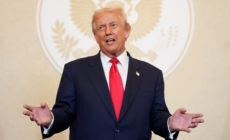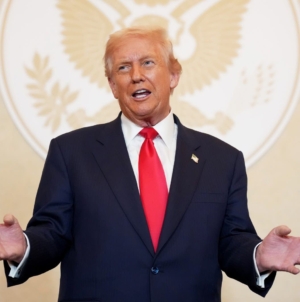-
Trump’s Net Approval Rating Hits Second- Term Low, Poll Shows - 18 mins ago
-
Cuba Is No Stranger to Hurricanes - 24 mins ago
-
He had a violent outburst at a SoCal hair salon, is headed to prison - 38 mins ago
-
Deion Sanders Sends Strong Message to Colorado Players Ahead of Arizona Game - 53 mins ago
-
Scenes From the Caribbean as Hurricane Melissa Hits - about 1 hour ago
-
A deputy killed. A 150 mph chase. Then, an off-duty cop took dramatic action on live television - about 1 hour ago
-
Flamingos, lions, lemurs: How Jamaica zoo gets ready for Hurricane Melissa - about 1 hour ago
-
F.C.C. Changes Course on the Price of Prisoners’ Phone Calls - 2 hours ago
-
Suspected ‘Shade Snatchers’ linked to more than $2.6 million in stolen eyewear arrested - 2 hours ago
-
Dodgers Reliever Sends Shohei Ohtani Message After Game 3 - 2 hours ago
International student arrivals take a dive under Trump
The number of international student arrivals in the U.S. dropped by nearly a fifth at the onset of this academic year, according to federal data, the latest sign of a hit to colleges’ foreign student enrollment as the Trump administration has ratcheted up scrutiny of their visas.
International visitors arriving in the U.S. on student visas declined 19% in August compared with the same month in 2024, according to the preliminary data released by the National Travel and Tourism Office. The numbers also declined in June and July, but August is the summer month that typically sees the most international student arrivals — 313,138 this year.
As the federal government has clamped down on student visitors, industry groups have warned of international enrollment declines that threaten school budgets and American colleges’ standing in the world. Although the extent of the change remains to be seen, the new data suggest a turnaround in international enrollment that had been rebounding in the U.S. from a decline worsened by the COVID-19 pandemic.
About 1.1 million international students were in the United States last year — a source of key revenue for tuition-driven colleges. International students are not eligible for federal financial aid, and many pay full tuition.
The picture in California
Many California campuses, including the University of California system, have not yet released data on fall enrollment but prepared for potential hurdles in attracting internationals.
For fall 2025 admissions — not enrollment — UC said its nine undergraduate campuses had offered seats to 3,263 more first-year international students, an increase of 17% over last year, according to data reported over the summer. UC also admitted 100,947 first-year California students, up more than 7% from last year,
UC said it increased international admits because of “rising uncertainty of their likelihood of enrollment.” It noted that the share of accepted internationals who choose to enroll is generally “substantially lower” than that of California residents and that the cost of being a non-Californian at UC has gone up. Last year, the UC Board of Regents approved a 10% increase of the “nonresident” tuition fee from $34,200 to $37,602.
At USC, the California campus that typically attracts the largest share of internationals in the state, there were also concerns over a potential dip in foreign student enrollment.
The campus saw a small decline in overall international enrollment, from 12,374 last academic year to 11,959 this fall. Chinese and Indian students made up more than half of the total foreign population, matching trends statewide.
But USC also grew its first-year international community, according to university data about this fall’s new undergraduate class.
Of the 3,759 new first-year students enrolled this fall, about 21%, or 789, are internationals. Last year, about 17% of the 3,489 first-years — 593 — were in the U.S. on visas.
California usually attracts the largest international college community of any state. In 2024, in addition to USC, the biggest draws were UC Berkeley, which enrolled 12,441 students; UC San Diego, 10,467 students; and UCLA, 10,446 students, according to data from the Institute of International Education. STEM fields — science, technology, engineering and math — were the most popular.
Visa challenges and travel bans blocked some students
Nationally, many students who had plans to study in the U.S. could not enter the country because of difficulty lining up visas. In late May, the State Department paused the scheduling of visa interviews for foreign students, which resumed three weeks later with new rules for vetting visa applicants’ social media accounts.
The timing of the pause had “maximum possible impact” for visa issuances for the fall semester, said Clay Harmon, executive director of the Assn. of International Enrollment Management, a nonprofit membership association.
A travel ban and other restrictions for 19 countries that the Trump administration announced in June created even more uncertainty for some students. Most of the countries included in the ban were located in Africa, Asia and the Middle East.
The federal data on international dips show those regions experienced the largest declines in international student arrivals this August, with drops of 33% from Africa, 17% from the Middle East and 24% from Asia — including a 45% decrease from India, the country that sends the most students to the U.S.
The data include new as well as returning students, but some who were already in the U.S. avoided traveling outside the country this summer for fear of problems reentering.
Students have concerns about the political climate, research funding and cost
Some international students and their families have been wary of the Trump administration’s wider crackdown on immigration. In the spring, the federal government stripped thousands of international students of their legal status, causing panic before the Trump administration reversed course. Trump also has called for colleges to reduce their dependence on foreign students and cap international enrollment.
Syed Tamim Ahmad, a senior at UCLA who grew up in Dubai, said he was considering applying to medical school in the U.S. before last spring, when sudden student visa cancellations and government suspensions of research funding to Harvard and other elite campuses began to intensify.
“When I was a freshman, it seemed that out of every country the U.S. provided the most opportunities in terms of access to research funding and resources,” said Ahmad, whose major is physiological science. “But by my senior year, a lot of these pull factors became push factors. Funding was cut down, affecting labs, and there is fear among international students about what they put on social media and what they put online. That sense of having freedom of speech in the U.S. isn’t the same.”
Ahmad is now planning to enroll at medical school in Australia.
“There is a similar feeling among many students — that if they are going to graduate school or continuing their studies they should go outside the U.S.,” said Ahmad, who previously served in UCLA’s undergraduate student government as an international representative. “But it’s not everyone. There are also still many people who believe that there are good opportunities for them in the United States.”
Zeynep Bowlus, a higher education consultant in Istanbul, said interest in U.S. universities among the families she works with had been declining over the last few years largely because of financial reasons and skepticism about the value of an American degree. Policy changes in the U.S. are adding to their concerns, she said.
“I try not to make it too dramatic, but at the same time, I tell them the reality of what’s going on and the potential hurdles that they may face,” Bowlus said.
Institutions in other countries have seized the opportunity to attract students who might be cooling on the U.S. Growing numbers of Chinese students have opted to stay in Asia, and international applications to universities in the United Kingdom have surged.
Elisabeth Marksteiner, a higher education consultant in Cambridge, England, said she will encourage families looking at American universities to approach the admissions process with more caution. A student visa has never been guaranteed, but it is especially important now for families to have a backup plan, she said.
“I think the presumption is that it’s all going to carry on as it was in the past,” Marksteiner said. “My presumption is, it isn’t.”
Kaleem is a staff writer for The Times. Seminera and Keller write for the Associated Press.
Source link


















